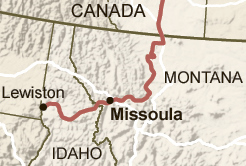 The prospect of huge truckloads of oil industry equipment using rural roads frequented by traveling bicyclists in Idaho and Montana has drawn the opposition of the Adventure Cycling Association.
The prospect of huge truckloads of oil industry equipment using rural roads frequented by traveling bicyclists in Idaho and Montana has drawn the opposition of the Adventure Cycling Association.
Beginning this year, what has been termed “megaloads” of oil exploration and refining equipment may begin rolling out from Lewiston, Idaho, on Highway 12 in Idaho and Montana, and Highway 200 in Montana (see map detail at left from New York Times).
How big are these megaloads? They are at least 3 stories high, at least 200 feet long and more than 24 feet wide — that's wider than the roads they'll use. They'll be rolling down parts of three scenic and popular bicycle routes — the TransAmerica Bicycle Trail, Lewis & Clark Bicycle Trail, and the Great Parks North Bicycle Route.
Destinations
The highways also are considered scenic byways by the US Department of Transportation and among the few roads in the U.S. that are considered tourist destinations.
Some of these loads will be heading to the ConocoPhillips Refinery in Billings, Montana. The other megaloads are processing equipment destined to the Kearl oil-sands project in northeastern Ontario. That oil-sand project is created by Imperial Oil, a Canadian subsidiary of ExxonMobil.
According to the Missoulian newspaper, 38 megaloads have arrived from Asia at the dock facilities in Lewiston and are ready for shipment by trucks.
ACA opposition
The Adventure Cycling Association is the latest in a string of organizations that has opposed using these scenic byways for megaload truck traffic.
The board of directors recently issued their opposition to the shipments. Executive director Jim Sayer explains:
“Adventure Cycling is especially concerned about the impact of the planned mega-load shipments on the rural character of these highway corridors and on the riding experience for cyclists on roads and associated facilities that will be drastically changed to accommodate the mega-loads.
“Adventure Cycling has also raised concerns about the mega-loads' threat to the sustainable tourism and travel economy that is emerging and growing along these highway corridors.”
The association, which is the largest bicycle touring group in the U.S., previously asked for a rigorous federal environmental impact study of the proposed shipments.
Hearing review
The Idaho Department of Transporation is taking the issue under advisement.
The case of the four megaload shipments to Billings was the subject of a hearing that latest until December. The Spokesman Review reported that the hearing officer ruled that megaload opponents provided no “reliable evidence” that the load shipment damage tourism, the scenic quality of the highway or hinder businesses in the mountainous region.
The case of the 207 megaload shipments by ExxonMobil to Alberta in 2011 is being considered separately. It will also require movement during the night, blocked sideroads, relocated powerlines, cutting of roadside trees to allow the megaloads to pass through tight spots and roadside parking areas where the rigs will remain when not in use.
Scenic rivers and outdoors
In addition to opposition from highway travelers — both bicyclists and motorists — fly fishermen and other outdoors enthusiasts are opposing the megaload proposals. For more information on the issue, check out All Against the Haul website.
The New York Times reports that the area has a rich history and culture dating back to the Native Americans and is the setting for such books and films as “A River Runs Through It,” by Norman McLean.

Recent Comments